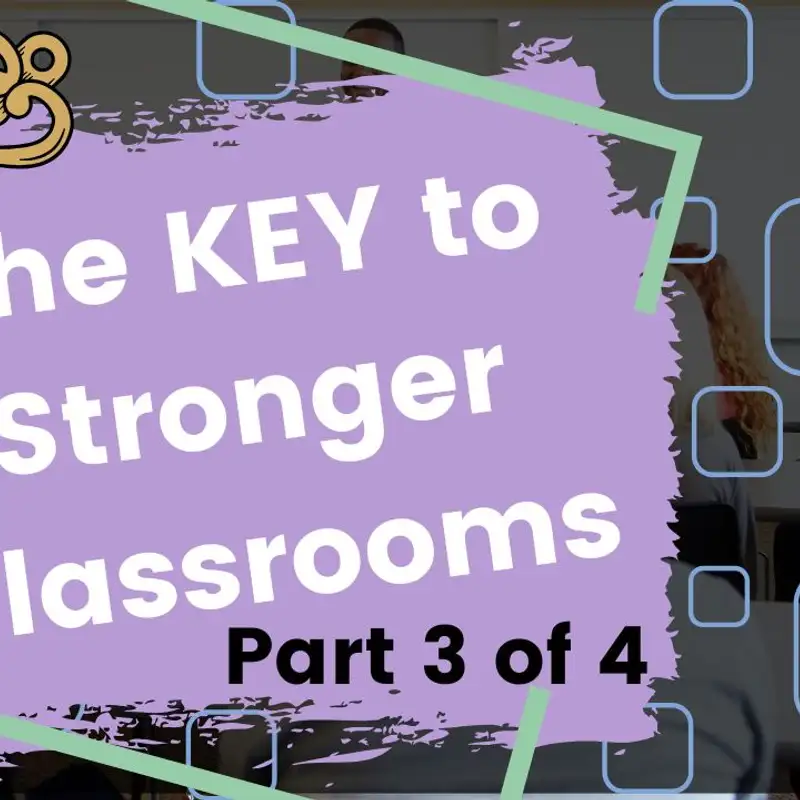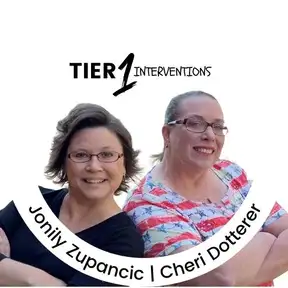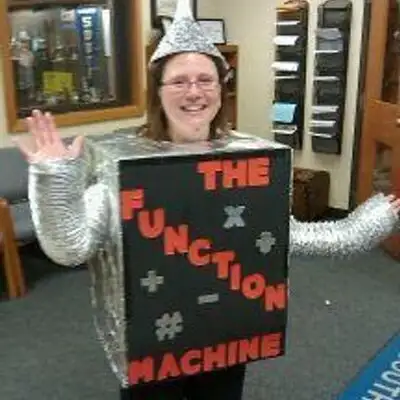
Rethinking Math Education Part 3: S2 E26
Speaker 4: Hey everybody!
Welcome to Tier 1 Interventions,
where we work on helping you
gain the core in your classroom.
I am Cheri Dotterer, your classroom coach.
That's Cheri with a C
and Dot with a stutter.
I'm here today with Jonily Zupancic,
your instructional coach on mathematics.
And we are here to help learn, help
you learn how to deliver your math
instruction in a very unique way.
Today we are going to talk
about the pain problem.
Jonily
Speaker 6: get us started!
Hey everybody.
I'm Jay-Z.
Jay-Z in the house, Jonily Zupancic and
Tier one Interventions is, as Sherry said,
strengthening your core regular classroom.
So this is for specifically the
classroom teacher, partnering with the
intervention specialist, instructional
coach, curriculum leader, principal.
Special Service Provider, Occupational
Therapist, Speech Therapist.
How can kids get exactly what they need in
the Tier 1 Core Regular General Classroom?
Too often we have kids leaving the
room to be pulled out for small
group Tier 2 or Tier 3 intervention.
This week we're going to
talk about part three of the
background to the paint problem.
Speaker 4: I was doing a webinar
for OTs earlier this month.
And one of the OTs that was on that call
said to me, I never even
considered that parentheses.
Square root sign.
The division sign would be something that
my kids needed me to address with them.
So I say this for your awareness as well.
Anybody who's out there listening to
the podcast that Not only do we need to
help kids with letters and numbers, we
also need to help them understand the
symbols that go with mathematics, the
symbols that go with social studies, the
symbols that go with music and science,
because they don't make the connections.
Speaker 6: When we talk about
improving number sense, we always
say this is an inborn, innate,
intuitive understanding of number.
That cannot be explicitly taught.
It must be experienced.
And that's what all of
this module is all about.
But Sherry makes a point.
What does need to be explicitly taught are
the connections between those conceptual
contextual experiences and the symbols
and notation that must be explicit.
We must tell kids exactly what it means.
over and over again and make those
connections to the conceptual.
But kids aren't just gonna
figure out a parenthesis.
They're not just gonna
figure out a square root.
That must be explicitly
and deliberately taught.
I say it, they hear it, and then they tell
me what I just said and they learn it.
So very important to understand this as
we're moving through the science of math.
That is up and coming.
The differences between what
needs to be explicitly taught in
mathematics and what cannot be
explicitly taught in mathematics.
With the science of reading,
the collection of research on
how students learn to read.
Reading must be explicitly taught.
That's what the collection
of science says for reading.
My fear when we move into science
of math is we're going to try
to parallel that for everything.
But what we're missing in schools
is a high level of number sense.
And that can never be explicitly taught.
It must only be experienced
through these things.
That experience is what is going to
provide The functional aspects for
students to be able to individualize
where they are and be able to
work independently on mathematics.
We seem to not be able to ever
get to a point in any classroom at
any grade level where students can
independently work on mathematics.
Because we're not focused on
iterated and repeated reasoning.
Using reference tasks and bringing
them back again with a different
number, kids already have been
explicitly taught the process.
Now they can independently repeat
the process with other numbers.
This is also how we individualize and
build independence in mathematics.
What are some of these other
non academic functional pieces?
That's the question that we're going
to answer here in this, in Part 2.
Part 2, what are some of the non
academic functional pieces that need
to be included in Tier 1 general?
Core instruction so the kids don't
have to be pulled out of the room to go
to a separate small group, a separate
teacher to learn how to function, behave,
regulate and manage their learning.
And I say this has to do with rate
because one of the examples of rate is.
Speed.
How fast?
That's innate and intuitive right there,
because as Teresa mentioned, when we go
to the gym and we get physical and we do
movement, we could have short distance
running races and use a stopwatch,
because what we're measuring is distance.
Per time, and that is the
pure definition of rate.
I don't have to teach it
as rate in second grade.
We can just do these short distance
runnings, and we can document the distance
to the finish line, and then the time
it took for each student to get there.
And we're collecting data, we're
experiencing it, we have physical
movement, and then we're going to
use those numbers for mathematics.
Now, not only can I improve my
number sense by seeing number
as shape, like with a quick dot.
to start to give meaning to number.
Now I can physically feel number.
Because I can see who is faster, and
whatever number that is, is going to
be a smaller number as far as time.
Because if I have the same
distance, finish line is at
the start and finish line.
I have the same distance for every race.
But the smaller the
number, Why does that mean?
The faster they got there because
the definition of rate, one of the
definitions for rate is distance per time.
So I can take my younger kids and
do these things and collect data and
now they can physically feel rate.
This is what we're missing in mathematics.
So that's a, that's an
example of a functionality.
A non academic way to put
movement into mathematics.
But also be able to improve
number sense experientially.
So let's talk about some other
functional non academic features
of interventions that can be done
in the regular Tier 1 classroom.
Speaker 4: Before you get
started, Sarah has a question.
Speaker 6: Sarah, question.
And I'm not going to get started.
I was going to turn it
over to you, Sherry.
Be ready with some other
functional interventions.
Speaker 9: Sarah, go ahead.
Okay.
I want to do two things.
And I don't want to sidetrack too much.
I did want to say yesterday at our like
pie event when you said rate, I was
thinking one of the moments I love.
Yesterday, the most I was doing this
we called it our bike race activity.
We basically had two hula hoops that
were, like, different bike wheel sizes.
And the so I tried to
keep the station flexible.
I changed the questions depending
on the students that were
there and what I felt like.
But I, had these two students and we one
of the questions I would ask is like how
estimate how many rolls of their wheel
they thought it would take to get to like
our finish line, which was marked off.
But this one.
This one brother and sister we got to
talking about the number of rotations
for the the wheels and I think this this
would relate to paint problem, right?
Because it's the inverse
relationship, right?
And I asked Or they came up with a
statement like the bigger wheel has less
rotations because of the length of it.
And the smaller wheel
would have more rotations.
Because of its length.
And so it's just really exciting to have
that rate conversation without using any
math We were just talking about what we
see, what we know, that kind of thing.
So that's more an observation comment.
My question though, was
hold off on that question
Speaker 6: point on that too.
And that is, that's just like fraction,
my younger kids, my younger students,
and even my older students, when
we do experiential contextual with
paper folding with fraction, they
will come to discover that, wait a
minute, the bigger the whole number.
When that number is the denominator of a
fraction, the more pieces, but the smaller
the piece, and that's really difficult for
kids to overcome unless they experience
it contextually and conceptually, and
one of our, I'm going to put this up
here, another reference task is paper
folding that we need kids to experience,
which is really connected to what
Sarah's talking about with the rotation
of the wheel, because it's that sort of
counterintuitive inverse understanding
when I ask kids, which is bigger?
1 8th or 1 4th?
1 8th is always the answer.
It's wrong, but it's very popular.
Okay, so kids need to understand
that the larger the number of
the denominator, the smaller the
pieces, and they only can do that.
I can tell them 500.
86 times.
And we do this in schools.
We tell them and tell them and
tell Guys, we've told you this!
We've told Yeah, you know what?
That's the problem!
Ding!
Insanity!
Doing the same thing over and
expecting a different result!
That's why we need to
unlearn, relearn, rethink.
These contextual, conceptual, experiential
ways of delivering math instruction so
that kids can figure it out on their own.
Then we can explicitly teach the
association and the connection
to the symbol and language.
Sarah, question though.
Speaker 9: Now you make me
think of our math night.
I did a recipe scaling with kids
and your fraction thing, right?
So we were talking about, I
told them, I said, when I bake,
I like to use as few tools.
A few measuring tools as possible.
So I don't have to clean as many things.
So when we were looking at the
recipe, like if it said, whatever the
measures were, and I said, what if
we only used the quarter teaspoon?
Like, how is that going to change?
You know what we do?
And one of the students
did get to that point.
We're using a smaller Teaspoon.
So we need more of them to and
which is what you're saying
about that fraction, right?
The like smaller, the denominator,
the more we're going to
need to like get to that.
So think about it
Speaker 6: when we skip count by eight.
And we skip count by 12s, which
one is going to get to 120 faster?
See, that's right.
But Sarah, let's talk
about this for a minute.
You teach in a cyber school.
So were you guys all together on site
Speaker 9: yesterday?
What's up?
Yeah.
Sorry.
So yesterday was a we host in
person events for like special, like
once a month or special occasions.
Like our pie day is one of those regional
activities and we were in person.
Love it so much.
Okay.
What's your question?
Sorry.
My question is back to the symbols.
Okay.
Because this comes up consistently
with the sixth grade teachers the,
Multiplication can transition to dot and
parentheses from the like little X. And
my question is, like, how early on is it
okay to start introducing the different
symbols to elementary students like Okay,
so like from the get go, just interchange
them and know it means the same thing.
Okay, all right.
Speaker 6: So what I'll sometimes do, this
is a good question, what I'll sometimes
do is remember when we had the 3x5 on
the dimension and blah, blah, blah?
Sometimes I'll just do three by five,
but I tell kids this is not a dot number.
That's our by three by five, because if
I put the.here, and I do this in kinder
one, two, if I put the.here, I have to
be very specific where the dot goes.
'cause this means three by five
rectangle, but this is a dot number.
It's a decimal number.
3. 50. So I'm introducing and exposing
that way early, starting in kindergarten.
By second grade, kids should be
able to see that My bi number, my
rectangle notation, and this is what's
important about calling that blank
multiplication chart the dimension chart.
I can use the word bi, I can use a dot,
I can use parentheses, and it really
has nothing to do with multiplication,
it's a notation of dimensions.
Follow up question on that.
Okay, other functional
non academic aspects.
Sherry, talk to us a little bit about what
that looks like in your setting and how
it can be done in the regular classroom.
Sure,
Speaker 4: what I mentioned this
a little earlier, I lost my page.
Where did it go?
I always have to have
pictures for everybody, right?
Speaker 2: All right.
Speaker 4: So I was talking
a little bit earlier about.
Interoception.
Interoception is the response
of our nervous system where it's
going to turn on and turn off.
parts of the body based
on what our needs are.
Our brain, our body, and our blood system,
and our nervous system, it wants to keep
our heart and our brain functioning.
So there are times in our system
where we don't send as much blood.
To our digestive system or different
parts of our body there, so
there's an actual nervous system.
It's called the autonomic nervous
system that turns on and turns off.
It'll increase or decrease blood
heart rate, depending on how
much activity we are needing.
I think I am sharing.
Oh no, I'm not sharing any screen yet.
The other part of it is feelings.
And that's what I want
to share the screen for.
And that is That we have eight
senses or eight emotions, joy,
trust, fear, surprise, sadness,
disgust, anger, and anticipation.
We have about 4, 000 feelings,
but the difference is that emotion
is that first seven seconds
before we even think about it.
It's that gut response that our body.
It does without us even thinking about it.
It is part of the subconscious.
It is part of our innate nature.
We talk about numeracy cycle being innate.
We've got eight core
emotions that are innate.
So kids that are refusing mathematics
or handwriting or whatever task you're
asking them to do, one of those eight,
most likely fear, is the Is overcoming
their ability to engage in the task.
So the emotion I said, there's
eight is a neurobiological response
to that initial gut reaction
before we can even think about it.
Once we can think about it.
Once it brings up into our conscious,
then we can evaluate it, and
that's when it becomes a feeling.
But there's also something else that
I haven't really ever talked about
before, and that is called mood.
And that is our disposition.
That is the kind of that
thing that lasts forever.
That's why people can get be in
a depressed mood or a sad mood.
That's different than emotion.
When it becomes this long
drawn out Disposition.
It's the way we're feeling over time.
That is our mood and we can change
those moods and that is going to
change that emotional response.
That in itself is the best
way to reengage kids in their
education is changing their mood.
It's the most difficult part of.
education.
But that is the key.
The key to making that
change is motivation.
So we need to change how they're
motivated to engage in the mathematics.
And what Jonily is teaching.
About engaging kids in mathematics is
a way of circumventing those moods and
remotivating kids into their education
Speaker 6: and what Sherry
and I together teach on.
And what she's talking about is
umbrella underneath this phrase,
focus triggers, a focus trigger
is the exact action that I, as the
facilitator and instruction can take.
With a student to reengage and to motivate
I'm going to go back to my kindergarten
audio yesterday in this kindergarten
class, and this was all non academic,
and this might be very criticized by.
Educators and administrators, but I'm
telling you, if you want kids to be
motivated intrinsically, if you want
kids to be able to function at a very
high level, if regardless of disability
or ability, if you want kids to be
able to engage in the task at hand.
and work independently.
You'll hear many focus triggers
on this kindergarten audio.
I'm going to tell you about
a few of them right now.
So whenever I teach a class of kids,
no matter the age level, in the
first three minutes, I can find out
how, who our special students are.
Okay, it's not rocket science.
Ended up finding out yesterday, and
you'll hear how I do this on the audio,
because what I will do is, I will give
some prompts to gather student perspective
to get a feel for the classroom.
And I might say, so yesterday I
introduced myself, I say I'm Mrs.
Zoo Panzick, Zoo, like where animals
are, Pan, like frying pan sick, like
you're not feeling well, say that.
Zupancic.
Boom, there's a focus trigger right there.
I give an association for my
name, then I make them say it.
That's actually two focus triggers.
Creating an association, my last name,
Zupancic, it's a little difficult.
Make an association.
Zoo, where animals are.
Pan, frying pan.
Sick, like you're not feeling well.
Okay, so that's one focus trigger
is to make that association.
And another focus trigger
is make them say it.
Make them repeat it.
Wrote.
Okay, so you guys say it.
Zoo, pan, sick.
Okay, so focus triggers.
There's two right there just very
subtle and you'll hear that in the
audio and now that I pointed it out
to you, it'll be very intentional.
You'll see that.
And so as I'm having them do this, I
watch for the kids that are laying on
their desks or being like, THE PIZZA!
Okay?
Hey, come on, I'm not exaggerating at all.
Okay, so then I go on and I start telling
them that I used to have a classroom like
this and I just like to go in different
math classrooms and do math with them.
And then I went on.
Another focus trigger
is to share the purpose.
Okay, another focus trigger
is to share the purpose.
I went on to say, How do
you guys exercise your body?
Oh, we work out.
You lift weights.
You can run.
That's all exercise for the body.
But what do we do to exercise the mind?
And they were like, We work out.
We lift weights.
We run.
I'm like, No.
I said, No.
No, that's, we exercise the body.
And then another little
lady, she raised her hand.
I called on her cause she
plays school really well.
And she's math.
I'm like, that is exactly right.
We do math to exercise
the mind, the brain.
So that is a perspective in and of itself.
So when I'm teaching kids, I
tell them, I don't teach math.
I teach thinking.
So when they ask gosh, when
are we ever going to use this?
Probably never.
You're never going to have to think.
Okay, the thing is, thinking is
my content, like I teach thinking
through the vehicle of mathematics.
See that's an unlearn, re,
relearn, rethink right there.
So if you are an educator, intervention
specialist, or instructional
facilitator, of mathematics.
You teach thinking.
You just use mathematics
to teach that thinking.
Couple other, and then then I
found out my good friend Jace.
I thought it was Chase, and then I was
like ch, and they were like, no juh, Jace.
I'm like, ooh, because my first name
is Jonaly juh, and then they were
like, oh, but we have juh, James,
and Jesse, and juh, and it was
just a whole thing, and it was fun.
And But the kid beside Jace kept speaking
for him, so I picked up on that, and
I said, Oh, are you his secretary?
He's yes, and I'm like, okay, I
need to keep this kid near Jace.
You pick up on these things, but what
I'm doing is I'm using focus triggers.
I'm getting kids to hone in and
focus on one thing so that they can
give me their perspective so that
I can teach to their perspective.
Okay, making a lot of
associations and connections.
So once I find out who Jace is, we
come to carpet, I make sure Jace is
near me and his secretary on carpet.
So that was beautiful, okay.
We go back to our seats, but
I make Jace stay with me.
Because I knew this kid needed
to wonk the willies out.
Okay, I knew explaining what we were going
to do with the 120 chart and starting
that facilitation with the kids before
I mini lessened to that small group.
I knew Jace needed to just be up
and moving and not at his table.
He wasn't going to get
anything out of that anyway.
So he was beside me and then
he started spinning and I'm
like, Jace, you keep spinning.
He would spin and then he'd jump and
then he'd spin and then he'd jump.
And then.
He was behind me and the whole class
was attending to me and ignoring Jace
because they know Jace is special.
So I move strategically to
another area of the room.
Jace stayed over there doing his
jumps and spins and whatever.
And then I finished explaining and I said
okay so now go ahead with your 120 chart.
I'm going to come to your
group, so I'm going to help you.
And I said, Jace, come on back.
And I said, Jace, No, sorry.
This was before they were
making squares with blocks.
Blah.
Jonily, you got the whole story messed up.
Anyway, doesn't matter.
The point is, while I was explaining
that we're going to make squares
and what that means and equal sides
and da, I totally screwed this up.
We should re record this, but we're
not going to because I'm out of time.
Anyway.
So then, he comes back, before I went
and observed other groups, when he
came back I said, Hey, do you know
what we're going to do right now?
And he's we're going to make squares.
I didn't expect him to say that,
because he was off over in La Land.
But do you see, he needed to
do all that, and it didn't
bother any of the other kids.
They didn't ask why he was doing that.
They probably intuitively
know why he's doing that.
He came back, and I wasn't expecting him
to say, we're making squares, but he did.
And I'm like, do you
know what a square is?
And he was getting a little weird and
I was like, you know what, here's your
blocks, go ahead and make squares.
And then he, for the next 10 minutes,
was so focused and engaged and in
tune and working independently.
See, focus, a focus trigger for
him, he's got to spin and jump.
Then he can attune to the task.
And he was listening
to every word you said.
Why?
Tune in next week where I
answer the question, why?
Episode Video
Creators and Guests


